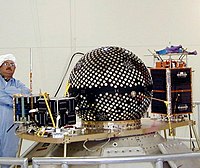 SAPPHIRE satellite | |
| Mission type | Communications |
|---|---|
| Operator | USNA / University of Santa Clara |
| COSPAR ID | 2001-043D [1] |
| SATCAT no. | 26932 |
| Mission duration | 2 years and 6 months |
| Spacecraft properties | |
| Manufacturer | Stanford University |
| Launch mass | 16 kg (35 lb) |
| Start of mission | |
| Launch date | 30 September 2001, 02:40 UTC |
| Rocket | Athena 1 LM-001 |
| Launch site | Kodiak LP-1 |
| Contractor | Lockheed Martin |
| End of mission | |
| Disposal | Decommissioned |
| Last contact | 2005 |
| Orbital parameters | |
| Reference system | Geocentric |
| Regime | Low Earth |
| Eccentricity | 0.0 [1] |
| Altitude | 794 km (493 mi) [1] |
| Inclination | 67° [1] |
| Period | 101 minutes [1] |
| Epoch | 30 Sep 2001 [1] |
SAPPHIRE (Stanford AudioPhonic PHotographic IR Experiment, also called Navy-OSCAR 45) was a satellite built by the Stanford University students in Palo Alto, California. [1]

The satellite was launched on September 30, 2001 together with Starshine 3, PICOSat and PCSat on an Athena 1 rocket at the Kodiak Launch Complex, Alaska, United States.
Its purpose was the training of students, the operation of an infrared sensor, a digital camera, a speech synthesizer and from 2002 the operation of an APRS digipeater. [2] He also served to train midshipmen of the US Naval Academy in the field of satellite control.
The satellite's mission ended in early 2005.
Frequencies
- Uplink: 145.945 MHz
- Downlink: 437.1 MHz
- Mode: 1200 bit/s AFSK
- Call sign: KE6QMD [3]
See also
External links
References
- ^ a b c d e f g NASA Goddard Space Flight Center. "SAPPHIRE". Retrieved February 15, 2020.
- ^ "SAPPHIRE (Stanford AudioPhonic Photographic IR Experiment)". eoportal.org. Retrieved 15 Feb 2020.
-
^ n2yo.com.
"SAPPHIRE". Retrieved 15 Feb 2020.
{{ cite web}}: CS1 maint: numeric names: authors list ( link)
 SAPPHIRE satellite | |
| Mission type | Communications |
|---|---|
| Operator | USNA / University of Santa Clara |
| COSPAR ID | 2001-043D [1] |
| SATCAT no. | 26932 |
| Mission duration | 2 years and 6 months |
| Spacecraft properties | |
| Manufacturer | Stanford University |
| Launch mass | 16 kg (35 lb) |
| Start of mission | |
| Launch date | 30 September 2001, 02:40 UTC |
| Rocket | Athena 1 LM-001 |
| Launch site | Kodiak LP-1 |
| Contractor | Lockheed Martin |
| End of mission | |
| Disposal | Decommissioned |
| Last contact | 2005 |
| Orbital parameters | |
| Reference system | Geocentric |
| Regime | Low Earth |
| Eccentricity | 0.0 [1] |
| Altitude | 794 km (493 mi) [1] |
| Inclination | 67° [1] |
| Period | 101 minutes [1] |
| Epoch | 30 Sep 2001 [1] |
SAPPHIRE (Stanford AudioPhonic PHotographic IR Experiment, also called Navy-OSCAR 45) was a satellite built by the Stanford University students in Palo Alto, California. [1]

The satellite was launched on September 30, 2001 together with Starshine 3, PICOSat and PCSat on an Athena 1 rocket at the Kodiak Launch Complex, Alaska, United States.
Its purpose was the training of students, the operation of an infrared sensor, a digital camera, a speech synthesizer and from 2002 the operation of an APRS digipeater. [2] He also served to train midshipmen of the US Naval Academy in the field of satellite control.
The satellite's mission ended in early 2005.
Frequencies
- Uplink: 145.945 MHz
- Downlink: 437.1 MHz
- Mode: 1200 bit/s AFSK
- Call sign: KE6QMD [3]
See also
External links
References
- ^ a b c d e f g NASA Goddard Space Flight Center. "SAPPHIRE". Retrieved February 15, 2020.
- ^ "SAPPHIRE (Stanford AudioPhonic Photographic IR Experiment)". eoportal.org. Retrieved 15 Feb 2020.
-
^ n2yo.com.
"SAPPHIRE". Retrieved 15 Feb 2020.
{{ cite web}}: CS1 maint: numeric names: authors list ( link)
